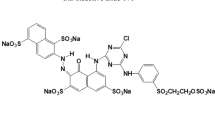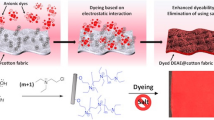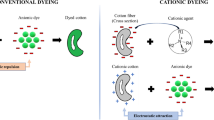Abstract
From a theoretical standpoint, the driving force for the deposition of ditallowdimethylammonium chloride (“DTDMAC” or “quat”) onto cotton must be distinguished from the nature of its interaction with cellulose. We found that the driving force is purely hydrophobic. Due to its strong hydrophobicity, DTDMAC is expelled out of the aqueous rinse bath and deposits onto available surfaces. Besides its tendency not to leave the cotton surface and return to solution (hydrophobic effect), it binds to cellulose by weak London dispersion forces. A strong Coulombic interaction occurs only when a negative charge is present. Consequently, the strong affinity of DTDMAC for cellulose mainly results from the large specific surface area of the fiber; negative charges play a secondary role. Much experimental evidence supports the hydrophobic nature of DTDMAC adsorption onto cellulose. DTDMAC deposits onto charge-free surfaces; its deposition is mainly governed by the available surface area, not by the surface nature. The hydrophobic nature of the interaction of DTDMAC with cotton may be displayed and distinguished from electrostatic binding. Structural effects demonstrate the correlation between hydrophobicity, deposition and the softening power of quaternaries. This model proposes a single mechanism to account for the deposition of DTDMAC onto cotton and synthetics. It is consistent with experimental facts that remain unexplained by the electrostatic model.
Similar content being viewed by others
References
Armak Chemicals Product Bulletin/3.3 (Akzo Chemie), Amersfoort.
Berenbold, H.,Tenside Surf. Det. 27:34 (1990).
Bräuer, K., H. Fehr and R. Puchta, Ibid.:281 (1980).
Bräuer, K., H. Nüsslein and R. Puchta,Seifen-Öle-Fette-Wachse 111:337 (1985).
Gillis, A.,J. Am. Oil Chem. Soc. 64:887 (1987).
Milwidsky, B.,HAPPI 9:40 (1987).
Puchta, R.,J. Am. Oil Chem. Soc. 61:367 (1984).
Ramsbotham, J.,Fabric Conditioners, International Flavor and Fragrance-Hilversum, 1989, pp. 2–4, 23, 63.
Ramsbotham, J.,Ibid., p. 12.
Rosen, M.J.,Surfactants and Interfacial Phenomena, 2nd edn., J. Wiley, New York, 1989, p. 19, 378.
Sobisch, T.,Tenside Surf. Det. 29:3 (1992).
Evans, W.P.,Chem. Ind. July:893 (1969).
Müller, H., and E. Krempl,Fette Seifen Anstrichm. 65:532 (1963).
Sexsmith, F.H., and H.J. White, Jr.,J. Colloid Sci. 14:598 (1959).
Suzawa, T., and M. Yuzawa,Yukagaku 15:20 (1966);Chem. Abs. 64:12864b (1966).
Van Senden, K.G., and J. Koning,Fette Seifen Anstrichm. 70:36 (1968).
Weatherburn, B.,Textile Res. J. 22:797 (1952).
Beal, C.M., L.A. Olson and M. Wentz,J. Am. Oil Chem. Soc. 67:689 (1990).
Egan, R.R., Ibid.:118 (1978).
Franks, F., inChemistry and Technology of Water-Soluble Polymers, edited by C.A. Finch, Plenum Press, New York, 1983, p. 168.
Jencks, W.P.,Catalysis in Chemistry and Enzymology, McGraw Hill, New York, 1969, pp. 418–428.
Kauzmann, W.,Advances in Protein Chem. 14:37 (1959).
Tanford, C.,The Hydrophobic Effect: Formation of Micelles and Biological Membranes, J. Wiley and Sons, Inc., New York, 1980, pp. 2–4, 24–26, 40.
Auerbach, M.E.,Ind. Eng. Chem. Anal. Ed. 15:49 (1943).
Auerbach, M.E., Ibid.:739 (1944).
Shaw, D.J.,Introduction to Colloid and Surface Chemistry, 3rd edn., Butterworths, 1983, p. 149.
Laughlin, R.G., inCationic Surfactants—Surfactant Series, Vol. 37, edited by D.N. Rubingh, and P.M. Holland, Marcel Dekker, New York, 1991, p. 464.
White, H.J., Jr., in Ibid., Vol. 4, 1970, p. 317.
Stackelberg, M., W. Kling, W. Benzel and F. Wilke,Kolloid Z. 135:67 (1954).
Hughes, G.K., and S.D. Koch,Soap Cosmet. Chem. Spec. Dec:109 (1965).
Paulus, W., and O. Pauli,Textilveredlung 6:217 (1971).
Bücking, H.W., K. Lötzch, and G. Tüber,Tenside Deterg. 16:2 (1979).
Linfield, W.M., J.C. Sherrill, G.A. Davis and R.M. Raschke,J. Am. Oil Chem. Soc. 35:590 (1958).
Author information
Authors and Affiliations
About this article
Cite this article
Crutzen, A.M. Study of the ditallowdimethylammonium chloride interaction with cellulose. J Am Oil Chem Soc 72, 137–143 (1995). https://doi.org/10.1007/BF02635791
Received:
Accepted:
Issue Date:
DOI: https://doi.org/10.1007/BF02635791




